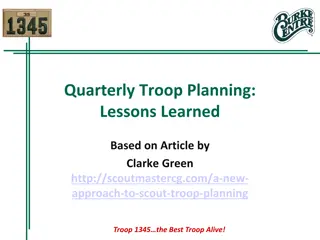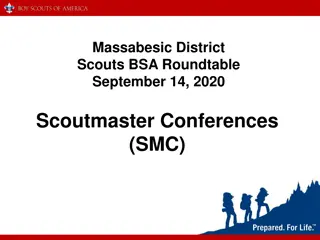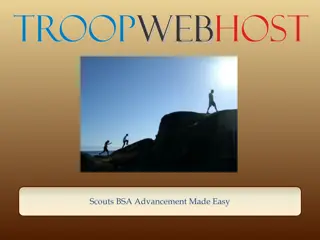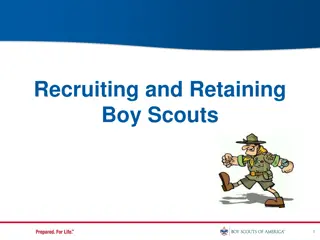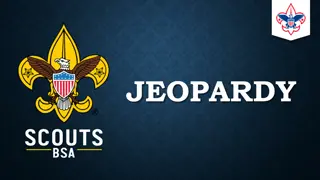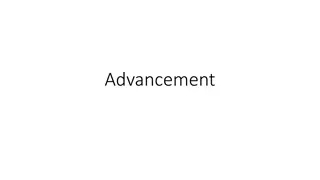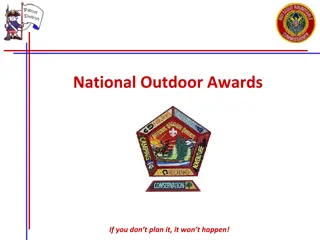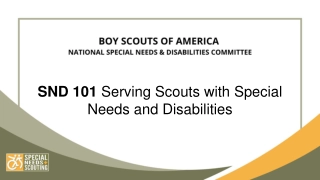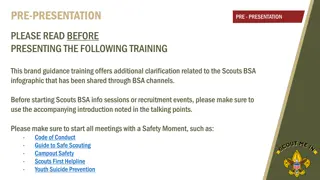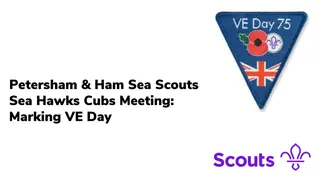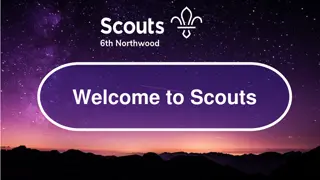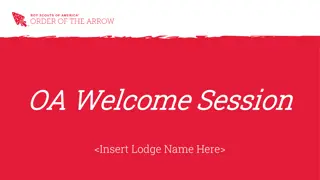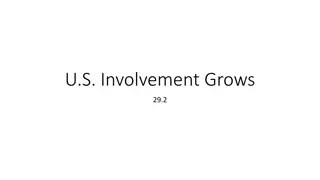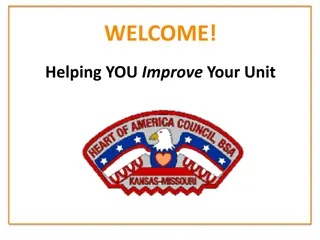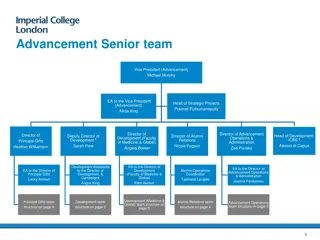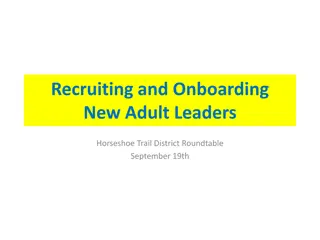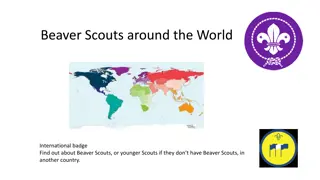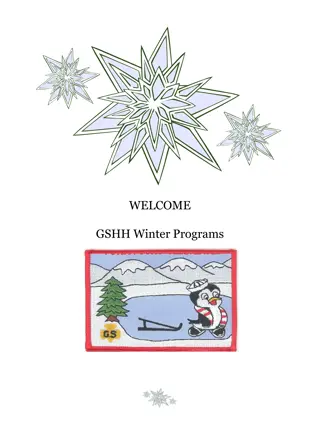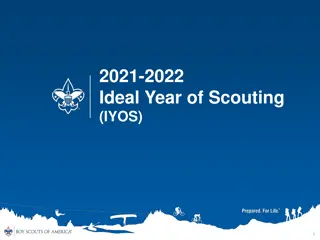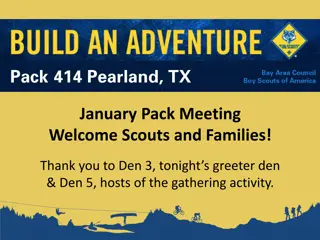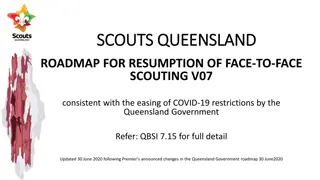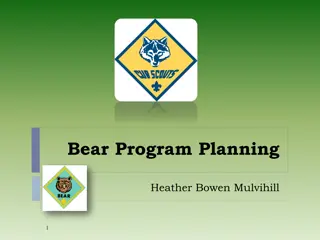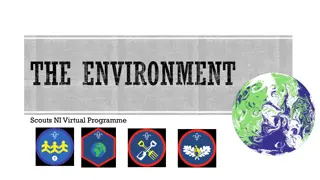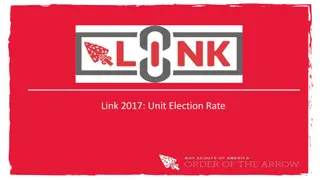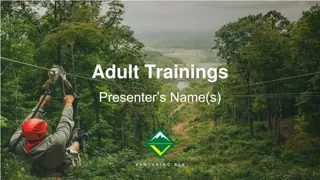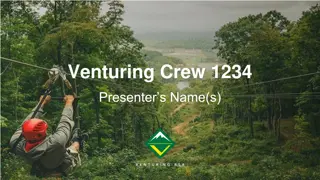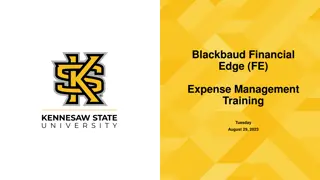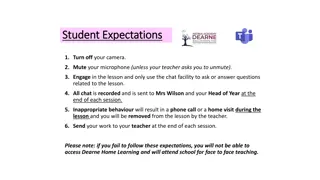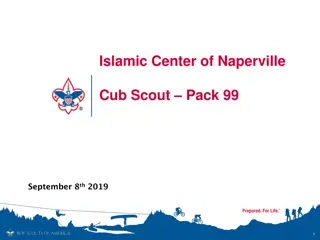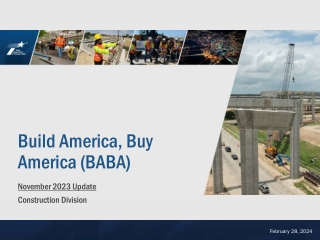Effective Troop Advancement in Boy Scouts of America
The Boy Scouts of America emphasizes the importance of advancement as a method to achieve character development, citizenship training, leadership skills, and mental and physical fitness. Advancement is a means for personal growth through age-appropriate challenges that allow Scouts to learn, gain confidence, and prepare them to make ethical choices. The advancement process involves learning, testing, reviewing, and recognition, ultimately leading to the growth and development of young individuals within the scouting program.
Download Presentation

Please find below an Image/Link to download the presentation.
The content on the website is provided AS IS for your information and personal use only. It may not be sold, licensed, or shared on other websites without obtaining consent from the author. Download presentation by click this link. If you encounter any issues during the download, it is possible that the publisher has removed the file from their server.
E N D
Presentation Transcript
Advancement Education BSA Effective Troop Advancement National Advancement Program Team Expiration Date This presentation is not to be used after January 31, 2023. Obtain an updated version at www.scouting.org/advancement
Why Advancement? Mission Statement The mission of the Boy Scouts of America is to prepare young people to make ethical and moral choices over their lifetimes by instilling in them the values of the Scout Oath and Scout Law. The Objectives of Scouting Character development Citizenship training Leadership Mental and physical fitness Advancement is one of the eight methods of Scouting used by Scout leaders to fulfill the objectives of the BSA. 2
Advancement is A method (2.0.0.1) Not an end in itself Based on experiential learning (2.0.0.2) Designed to educate or expand horizons A means for personal growth (2.0.0.3) Age-appropriate, surmountable hurdles that allow Scouts to learn and gain confidence 3
Four Steps of Scout Advancement (4.2.1.0) Learn Test Review Recognize 4
A Scout Learns (4.2.1.1) A Scout learns by doing, they grow, and then they teach -Scout Handbook The EDGE method is a four step teaching method: Explain Demonstrate Guide Enable 5
A Scout is Tested (4.2.1.2) The unit leader authorizes those who may test and pass the Scout on rank requirements. These might include patrol leaders, the senior patrol leader, an assistant unit leader, another Scout, or the unit leader. Merit badge counselors teach and test the requirements for merit badges. It is important that everyone understands that a Scout completes the requirements as written. 6
A Scout is Reviewed (4.2.1.3) After completing all requirements for a rank, the Scout meets with a board of review. For Scout rank, no board of review is held. For Tenderfoot, Second Class, First Class, Star and Life ranks, the board of review is comprised of 3 to 6 members of the unit committee. Local councils determine the level at which Eagle Scout boards of review are held. 7
A Scout is Recognized (4.2.1.4) Recognition builds confidence and leads to additional advancement. Rewards the Scouts for their hard work Helps motivate them to continue Provides a reminder for other Scouts to advance Recognition should be immediate and repetitive. 8
Troop Advancement Responsibilities (3.0.0.3) The troop advancement coordinator s responsibility is to support the unit s advancement program, maximize rank achievement, and facilitate a smooth process. Some troops may also organize an advancement committee chaired by an advancement coordinator. All advancement administrators must know and understand advancement procedures. 9 9
Unit Advancement Coordinator (3.0.0.3) Supports unit leader s vision for advancement. Educates parents or guardians and unit leaders to stimulate advancement within the troop. Helps plan, facilitate, and conduct regularly scheduled courts of honor. Obtains necessary badges and certificates. 10
Unit Advancement Coordinator (3.0.0.3) Know and understand the advancement procedures for the program served, especially for Eagle, Summit, and Quartermaster. Assists the unit leader in establishing practices that will allow each new Scout to achieve First Class within 12 to 18 months of joining, and Star rank soon thereafter. Arranges for timely boards of review (monthly is suggested), and invites Scouts who are ready for them. 11
Unit Advancement Coordinator (3.0.0.3) Keeps advancement records and submits advancement reports to the troop committee. Use the BSA s internet portal to report advancement to the local council. Keeps a current copy of the district or council provided merit badge counselor list. With youth leadership, helps maintain a library of advancement literature. 12
Unit Advancement Coordinator (3.0.0.3) Learns about and promotes other Scouting awards and recognitions. Troops must report all advancement to the local council via Scoutbook or other method. Advancement should be reported at least monthly to ensure current and accurate records. 13
Unit Advancement Responsibilities: Reporting (4.0.0.2) It is strongly recommended that units utilize the BSA s current electronic advancement tools such as Scoutbook for reporting advancement. Units that do not have internet access must submit the Advancement Report #34403. All badges of rank, merit badges, and Eagle Palms are restricted items, not to be sold without a completed advancement report. 14
Scouting Ranks and Advancement Age Requirements (4.2.0.1) Scout, Tenderfoot, Second Class, and First Class requirements can be worked on simultaneously after joining a troop. However, they must be earned in order, with Scout rank first. Star, Life, and Eagle ranks must be earned in order. All of the requirements for these ranks, except those related to merit badges, must be fulfilled after the successful completion of a board of review for the previous rank. 15
Unit Advancement Mechanics (4.2.0.0) All rank requirements must be completed exactly as written no more and no less. All Scouts BSA rank advancements must be completed prior to age 18 unless special circumstances apply.(See section 10 of the GTA for further information.) Time extensions for Eagle Scout rank may be requested under extenuating circumstances. 16
Merit Badges (7.0.1.0) Merit badge counselors must be BSA registered this is in addition to unit leader registration. Merit badge counselors must be approved by the local council. The council or district furnishes the merit badge counselor lists to the units. 17
Merit Badges Merit badge counselors must complete Youth Protection training every two years. Merit badge counselors must be men or women of good character, age 18 or older, and must have recognized skills. A youth member must not meet one-on-one with an adult. (7.0.3.1) All youth protection policies must be followed as outlined in the Guide to Safe Scouting. 18
In Summary, Advancement Encourages Scouts to learn new skills and explore new subject areas Provides a tangible reward for hard work Helps build confidence Facilitates a Scout s personal growth Provides a method to further the objectives of Scouting 19
For More Information Other advancement presentations are available at: www.scouting.org/advancement Resources Guide to Advancement, No. 33088 Scouts BSA Requirements, No. 33216 Scouts BSA Handbook, No. 34622 and 39006 Merit Badge Counselor Information, No. 34405 20


